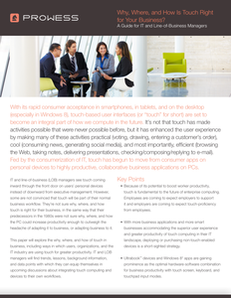With its rapid consumer acceptance in smartphones, in tablets, and on the desktop (especially in Windows 8), touch-based user interfaces (or “touch” for short) are set to become an integral part of how we compute in the future. It’s not that touch has made activities possible that were never possible before, but it has enhanced the user experience by making many of these activities practical (voting, drawing, entering a customer’s order), cool (consuming news, generating social media), and most importantly, efficient (browsing the Web, taking notes, delivering presentations, checking/composing/replying to e-mail). Fed by the consumerization of IT, touch has begun to move from consumer apps on personal devices to highly productive, collaborative business applications on PCs.

